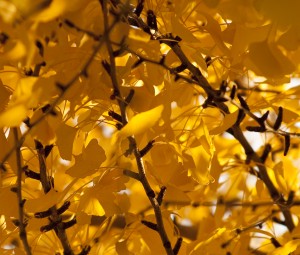The Maidenhair of Paracelsus
Posted in Learning Experiences on March 1 2012, by Matt Newman

Look at the maidenhair tree and you’ll see nothing worth taking to the salon. You may see “duck feet” in the leaves, as some Asian cultures have, but certainly no flowing mane of vegetal locks. Botanical nomenclature is a lot like the horse racing circuit in that regard–every so often you stumble over a designation that makes not even a whit of sense. Thus, to explain the common name of Ginkgo biloba, we need to think smaller.
“Fern” small, actually. The humble maidenhair fern (Adiantum aethiopicum happens to be sitting on our window sill), with its cascades of dainty green leaves, is the true point of origin for the towering ginkgo’s street moniker. And if you compare the two, you’ll see what many would call a family resemblance (if the ginkgo were directly related to anything else on this planet; it’s not). Each has leaves resembling the foot of a waterfowl. So why aren’t they named as such? To answer that, we look even further down.
When dug up, the maidenhair fern displays a system of roots covered in stringy, ephemeral tendrils, threading out to resemble the mythical hair that has until now proven so elusive. You can follow the convoluted series of comparisons up to the ginkgo. Yet there’s more to this story than a few misguided moments in the tagging of a lazy botanist, thanks to the quirky ideas of one Phillipus Aureolus Theophrastus Bombastus von Hohenheim. He came to be known as Paracelsus in the 16th century–I’m sure you can come up with a suitable explanation for the substitution.

This Renaissance man was a paragon of the type: he dabbled in alchemy, medicine, astrology, mining, and the occult to name but a few disciplines. But for our purposes, we focus on his experience in botany. Paracelsus’ confidence in his chosen profession(s) was so egomaniacal that he quite literally threw out the book on medicine–by burning it. While serving as Professor of Medicine for the University of Basel in Switzerland, he happily torched the medical tomes of Avicenna, Galen, Dioscorides, and Theophrastus (a “misstep” which later got him fired). But he wasn’t above pilfering a few of their more peculiar ideas.
Prior to Paracelsus, the Doctrine of Signatures existed more as a conceptual philosophy recognized by the very classical thinkers he was immolating. Some advocates argued that, because a higher power must have a vested interest in the well-being of humanity, it would leave clear signs in the resources of the Earth dictating what use they had against disease; if the Almighty created disease, he must have left obvious cures for said disease lying around for the taking. For physicians of the time, it was thus understood that a plant’s usefulness was dependent on its color and shape. If it looked like a stomach and it was the same color as a stomach, it must be good for the stomach.

It sounds like the lunacy of someone dosed with mercury (that, too, was considered “medicine” back then), but considering the state of medical canon up until the 20th century, we can’t hold a little crazy against the people of the Renaissance. They were still a far sight better off than those in the Dark Ages, after all.
The Doctrine of Signatures as perfected and published in the writings of Paracelsus is the inspiration behind many of the plant names we have today. And many of them happen to be “worts.” The suffix was derived from the Old English wyrt, itself pulled from a Germanic term which meant “plant” or, more specifically, “root.” In turn, we end up with bloodwort, liverwort, cancerwort, lousewort, lustwort, and a few hundred other similarly-dubbed “medicinal” plants. One, known as spleenwort, was so laden with anatomical similarities that it warranted two names: maidenhair spleenwort.
The maidenhair genus of ferns (then a broad, haphazard grouping) came into peak popularity in the 17th century, when English herbalist John Gerard described its potent healing powers in The Herbal, General Historie of Plants:
“It consumeth and wasteth away the King’s Evil and other hard swellings, and it maketh the haire of the head or beard to grow that is fallen and pulled off.”
Does applying the maidenhair fern or even the ginkgo leaf to your bald spot earn you a plush new pompadour? Sadly, no–modern science handily debunked the Doctrine of Signatures as superstition. But as categorization goes, it’s much easier to stick with the sobriquets of your forebears than to rename everything for the sake of accuracy. So the next time you happen upon a plant with a name you can’t for the life of you puzzle out, consider that a madcap botanist from a century long since passed may once have sat down at his desk and thought it good for gout.

